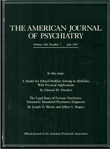Corneal and lenticular opacities in mentally retarded young adults treated with thioridazine and chlorpromazine
Abstract
Of 18 mentally retarded institutionalized subjects who had received long-term, high-dose treatment primarily with thioridazine or chlorpromazine, 2 developed definite corneal and lenticular opacities and 2 had equivocal ocular changes. In view of this finding, the authors suggest that alternative treatment, including different neuroleptics, be considered with mentally retarded institutionalized subjects; when that is not possible, subjects should be given periodic evaluation, including annual slit-lamp examination.
Access content
To read the fulltext, please use one of the options below to sign in or purchase access.- Personal login
- Institutional Login
- Sign in via OpenAthens
- Register for access
-
Please login/register if you wish to pair your device and check access availability.
Not a subscriber?
PsychiatryOnline subscription options offer access to the DSM-5 library, books, journals, CME, and patient resources. This all-in-one virtual library provides psychiatrists and mental health professionals with key resources for diagnosis, treatment, research, and professional development.
Need more help? PsychiatryOnline Customer Service may be reached by emailing [email protected] or by calling 800-368-5777 (in the U.S.) or 703-907-7322 (outside the U.S.).



